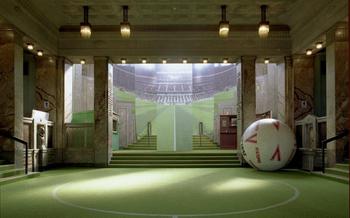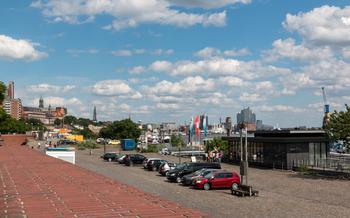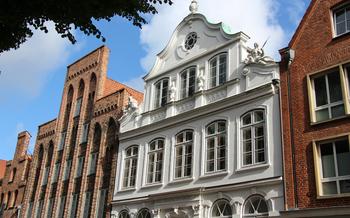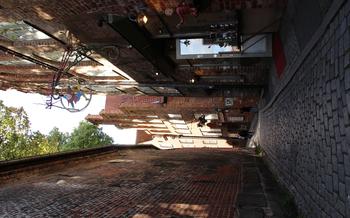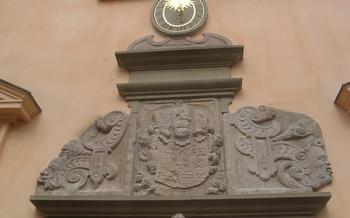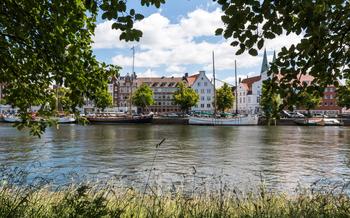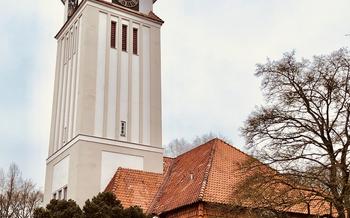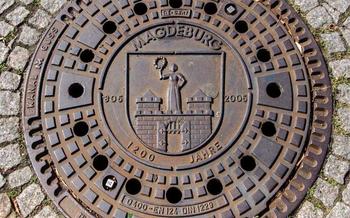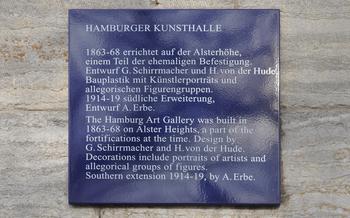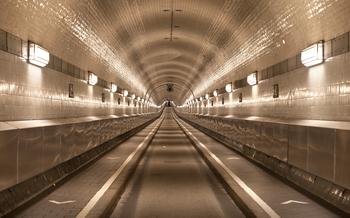
Viermastbark Passat (Four masted Barque Passat)
- A Symbol of Maritime History
- Exploring the Decks
- Immersive Exhibitions
- The Captain's Quarters
- Life Aboard the Passat
- The Engine Room
- The Hold and Cargo
- The Ship's Bell
- The Figurehead
- The Wheelhouse: Steering the Course
- Temporary Exhibitions
- Educational Programs
- Events and Activities: A Vibrant Maritime Experience
- Accessibility and Facilities
- Insider Tip: Uncover the Hidden Treasure of the Passat
A Symbol of Maritime History
The Viermastbark Passat, a majestic four-masted barque, stands as a testament to the rich maritime history of Germany. Built in 1911 at the Blohm & Voss shipyard in Hamburg, the Passat embarked on its maiden voyage in 1913, carrying grain from Australia to Europe. During its illustrious career, the ship sailed the world's oceans, transporting diverse cargoes along the global trade routes.
In an era dominated by steam-powered vessels, the Passat represented the pinnacle of sailing technology. Its impressive dimensions, with a length of 115 meters and a beam of 14 meters, allowed it to carry vast quantities of goods. The ship's four masts, towering over the deck, supported a staggering 42 sails, enabling it to harness the power of the wind and navigate the vast expanses of the seas.
Despite its age, the Passat remains remarkably well-preserved, thanks to meticulous restoration efforts undertaken over the years. Today, it stands as a living museum, offering visitors a glimpse into the golden age of sailing ships. Its authentic appearance and intact rigging transport visitors back in time, allowing them to experience the grandeur and romance of maritime history firsthand.
Exploring the Decks
The Viermastbark Passat welcomes visitors to embark on a journey of discovery through its various decks. Begin your tour on the main deck, where you can admire the ship's impressive size and sturdy construction. Ascend to the upper decks to experience panoramic views of Lübeck and the surrounding landscape. Explore the bridge, where the ship's captain and crew once navigated the vast oceans. Climb the rigging and reach the crow's nest for a bird's-eye perspective of the harbor and the city. Delve into the ship's cargo holds, where diverse goods from around the world were once stored. Learn about the intricate systems and techniques used to load and unload cargo during the ship's active trading years.
Each deck of the Passat offers a unique perspective on the ship's history and operation. Imagine the bustling activity as sailors maneuvered the ship, hoisted sails, and navigated through treacherous waters. Immerse yourself in the challenges and triumphs experienced by the crew as they sailed across the globe, carrying precious cargo and connecting distant shores.
Immersive Exhibitions
The Viermastbark Passat is not just a static museum piece; it's a living testament to the rich history of seafaring. The ship's immersive exhibitions bring to life the stories of its past voyages, its diverse cargo, and the people who sailed aboard it.
Thematic displays showcase the ship's involvement in global trade routes, transporting everything from grain and spices to machinery and manufactured goods. Interactive exhibits provide insights into the lives of the crew and passengers, revealing their challenges, triumphs, and everyday experiences on the high seas.
Multimedia presentations add a dynamic element to the exhibitions, using audio-visual technology to recreate the sounds and sights of life on board the Passat. Historical artifacts and documents, such as logbooks, maps, and photographs, add authenticity to the displays, providing a tangible connection to the ship's past.
Through these immersive exhibitions, visitors can step back in time and experience the excitement and adventure of sailing on a tall ship during the Age of Sail. They gain a deeper understanding of the significant role that the Viermastbark Passat played in maritime history and the global economy.
The Captain's Quarters
Step into the private domain of the ship's captain, where decisions were made, and the course was set. Explore the captain's cabin, a sanctuary of authority and responsibility. Admire the intricate details of the furnishings, chosen to withstand the rigors of seafaring life. Imagine the captain poring over charts, navigating the vast oceans, and ensuring the safety of his crew.
In the captain's study, discover a world of maps, books, and navigational instruments. Each item tells a tale of distant lands, charted courses, and the challenges of command. Imagine the captain pondering his next move, weighing the risks and possibilities that lay ahead.
The captain's dining area, though modest, speaks volumes about the camaraderie and shared experiences of those who sailed aboard the Passat. Picture the captain and his officers gathered around the table, sharing meals, stories, and the bond forged through countless days at sea.
Life Aboard the Passat
Imagine stepping aboard the Viermastbark Passat and being transported back in time to the era of tall ships and global exploration. As you wander through the ship's decks, you'll gain insights into the daily lives of the crew and passengers who sailed these vast oceans.
Explore the crew's quarters, where they slept, ate, and socialized during their long voyages. Each bunk tells a story of camaraderie, endurance, and the challenges faced by those who worked aboard the ship.
In the ship's galley, discover the secrets of the meals that sustained the crew and kept them going through storms and calm waters alike. Imagine the aromas of freshly baked bread, hearty stews, and the occasional treat that brightened their days.
As you explore the ship's recreational areas, you'll learn how the crew found ways to relax and unwind during their off-duty hours. From simple games and storytelling to impromptu music sessions, these moments of camaraderie helped foster a sense of community aboard the Passat.
Through interactive displays and storytelling, you'll hear tales of the passengers who sailed on the Passat. Learn about their hopes and dreams, the adventures they sought, and the experiences that shaped their lives during their time aboard this historic vessel.
The Engine Room
The engine room of the Viermastbark Passat is a fascinating realm of machinery and engineering marvels. Delving into its depths, visitors can witness the ship's beating heart, the massive steam engine that once propelled this majestic vessel across the world's oceans. The engine room is a testament to the ingenuity and craftsmanship of its designers and builders, showcasing the intricate workings of pistons, gears, and valves.
Learning about the engine room's operations provides insights into the ship's propulsion system and the challenges faced by engineers during long voyages. Visitors can marvel at the sheer size and complexity of the engine, appreciating the expertise required to maintain and repair this vital machinery. The engine room's deafening roar and the rhythmic pulse of the engine create a sensory experience that transports visitors back to the days when the Passat sailed the high seas.
Discovering the engine room on a guided tour offers a unique glimpse into the ship's inner workings and the lives of the engineers who tirelessly kept the Passat moving forward. It's a chance to witness the power and precision of steam technology, gaining a deeper appreciation for the engineering marvel that made the Passat one of the most formidable sailing ships of its time.
The Hold and Cargo
The Viermastbark Passat's spacious holds once played a crucial role in global trade, serving as the ship's lifeline to distant shores. These cavernous compartments, nestled deep within the ship's structure, witnessed the loading and unloading of diverse goods that shaped the economies of nations.
Grain, a staple commodity, filled the holds, nourishing far-off populations. Spices, with their exotic aromas and flavors, added a touch of adventure to the ship's journeys. Machinery, the harbingers of industrial progress, found their way into the holds, destined to transform distant lands.
Each voyage brought a unique cargo, reflecting the ever-changing demands of the global marketplace. The holds teemed with activity as stevedores, with their weathered hands and sturdy backs, skillfully loaded and unloaded the precious goods. The air buzzed with a symphony of voices, the clang of machinery, and the creaking of ropes as the ship's crew orchestrated the intricate dance of cargo handling.
Imagine the bustling atmosphere as merchants and traders eagerly awaited the arrival of the Passat, their fortunes tied to the safe delivery of their goods. The holds, like a treasure chest, held the promise of wealth and prosperity, fueling the dreams and ambitions of those who dared to venture across the vast oceans.
The Ship's Bell
In the maritime world, the ship's bell holds a profound significance, serving as a vital tool for communication, signaling, and timekeeping aboard the vessel. On the Viermastbark Passat, the ship's bell played a crucial role in coordinating the crew's activities, marking the ship's position, and ensuring the safety of all on board.
The bell, located prominently on the ship's deck, was rung at regular intervals to signal the time, ensuring that the crew maintained a synchronized schedule. It also played a vital role in signaling other ships, particularly in foggy or low-visibility conditions. The distinct sound of the bell carried across the water, allowing nearby vessels to determine the Passat's presence and avoid collisions.
Beyond its practical functions, the ship's bell on the Passat held a symbolic meaning. It represented the unity and camaraderie of the crew, who relied on the bell to guide their daily lives and work together seamlessly. The bell also served as a reminder of the ship's history and the many voyages it had undertaken, carrying precious cargo and connecting distant lands.
Today, visitors to the Passat can still hear the ship's bell ringing, echoing through the decks and evoking the spirit of maritime tradition. It stands as a testament to the ship's enduring legacy and the important role it played in the Age of Sail.
The Figurehead
The figurehead of the Viermastbark Passat is a captivating work of art that holds both artistic and symbolic significance. Carved from wood, the figurehead depicts a proud and majestic woman with flowing hair and a determined gaze. She stands tall, facing forward, as if guiding the ship through the vast oceans.
The figurehead's history can be traced back to the ship's construction in 19It was a common practice at the time to adorn ships with figureheads, which were believed to bring good luck and protection during voyages. The Passat's figurehead was carefully crafted by skilled artisans, who paid meticulous attention to detail, capturing the woman's serene expression and intricate features.
The figurehead's placement on the ship is of particular importance. Located at the bow, it serves as a focal point and a symbol of the ship's identity. Sailors believed that the figurehead would guide and protect the ship, watching over its crew and passengers as they sailed across the seas.
Over the years, the Passat's figurehead has become an iconic symbol of the ship and its rich history. It has stood witness to the ship's many voyages, weathered storms, and experienced countless adventures. Today, the figurehead remains an integral part of the ship, serving as a reminder of its enduring legacy and the timeless allure of the sea.
The Wheelhouse: Steering the Course
At the helm of the Viermastbark Passat, visitors can step into the ship's wheelhouse, the nerve center of navigation. This is where the helmsman, using the ship's wheel, meticulously guides the vessel through the vast oceans.
Exploring the wheelhouse, one can marvel at the intricate steering system and the array of navigational instruments that aided sailors in charting their course across the globe. Visitors can learn about the helmsman's crucial role in maintaining the ship's direction, especially during challenging weather conditions or when navigating through narrow waterways.
If fortune favors, visitors might even have the opportunity to take the helm themselves, experiencing the thrill of steering this majestic ship. Under the watchful guidance of the experienced crew, they can feel the weight of responsibility as they navigate the Passat through the waters, following in the footsteps of countless sailors who have sailed these seas before them.
Temporary Exhibitions
The Viermastbark Passat also hosts a variety of temporary exhibitions that delve deeper into specific maritime themes, historical events, or artistic expressions related to the ship and its era. These exhibitions are curated by experts and offer a unique perspective on the ship's history and significance.
Temporary exhibitions have covered diverse topics such as the role of the Passat in the grain trade, the experiences of female sailors, and the impact of maritime exploration on global cultures. Through interactive displays, multimedia presentations, and historical artifacts, these exhibitions bring the ship's stories to life and provide visitors with a deeper understanding of the maritime world.
The planning and curation of these exhibitions involve collaboration between historians, maritime experts, and museum professionals. They carefully select artifacts, conduct research, and design engaging displays to create a memorable and educational experience for visitors.
Each temporary exhibition offers a unique opportunity to explore different aspects of maritime history and culture. Visitors can learn about the challenges and triumphs of seafarers, discover the impact of maritime trade on global economies, and appreciate the artistic and cultural expressions inspired by the sea.
Educational Programs
The Viermastbark Passat serves as an educational platform, offering a unique opportunity for visitors to delve deeper into the world of maritime history and science. Guided tours are available, providing insights into the ship's construction, voyages, and the lives of the crew and passengers. These tours are led by knowledgeable guides who bring the ship's stories to life, making the visit both informative and engaging.
The ship also offers educational workshops and programs tailored to various age groups and interests. These programs cover topics such as navigation, sailing techniques, and the global trade routes of the past. Hands-on activities, interactive displays, and multimedia presentations make learning about maritime history fun and engaging for visitors of all ages.
Collaboration with educational institutions plays a crucial role in the ship's educational mission. The Passat works closely with schools, universities, and maritime academies to develop educational programs that align with their curricula. These programs provide students with a unique opportunity to learn about maritime history, science, and technology in a hands-on, interactive environment.
Through its educational initiatives, the Viermastbark Passat contributes to the preservation and dissemination of maritime knowledge, ensuring that the stories and traditions of the seafaring past continue to inspire and educate future generations.
Events and Activities: A Vibrant Maritime Experience
The Viermastbark Passat is not just a static museum; it's a vibrant hub for maritime events and activities throughout the year. From lively festivals to enchanting concerts and special themed events, the ship comes alive with a unique atmosphere that transports visitors to a bygone era.
Maritime festivals, held on select dates, celebrate the rich seafaring heritage of Lübeck and the Passat. These events showcase traditional crafts, music, and culinary delights, offering a glimpse into the lives of sailors and traders of the past. Visitors can witness demonstrations of rope-making, net-mending, and other skills essential for life at sea.
For music enthusiasts, the Passat hosts intimate concerts and performances in its atmospheric surroundings. The ship's decks and hold provide unique acoustics, creating a magical ambiance for musicians and listeners alike. From classical melodies to sea shanties and contemporary tunes, the music program caters to diverse tastes.
Special events, such as themed evenings or reenactments, take visitors on a journey through time. They can participate in historical role-playing, learn about the ship's voyages through interactive storytelling, or witness demonstrations of traditional navigation techniques. These events offer a deeper understanding of the Passat's significance and the challenges faced by sailors during its active years.
Whether you're a maritime enthusiast, a music lover, or simply seeking a unique experience, the Viermastbark Passat offers a captivating calendar of events and activities. Check the ship's website or contact the Lübeck Tourist Information Center for upcoming events and schedules. Join the festivities and immerse yourself in the vibrant maritime spirit of this historic vessel.
Accessibility and Facilities
The Viermastbark Passat is committed to providing an inclusive and comfortable experience for all visitors. The ship is wheelchair accessible, with ramps and elevators connecting the different decks. Accessible restrooms are also available throughout the ship.
For the convenience of visitors, the Passat offers a variety of facilities. A gift shop is located on board, where visitors can purchase souvenirs and mementos of their visit. A café is also available, offering a range of refreshments and snacks.
To ensure a smooth and enjoyable visit, it is recommended that visitors plan ahead and familiarize themselves with the accessibility features and facilities available. Visitors with specific needs or questions are encouraged to contact the Passat's staff in advance for assistance.
Practical tips for planning a visit with specific needs:
- Advance planning is key. Contact the Passat's staff in advance to inquire about specific accessibility needs or to arrange for assistance.
- Arrive early to avoid crowds and to have ample time to explore the ship at your own pace.
- Take advantage of the available resources. The Passat's staff is knowledgeable and helpful, and they are always willing to assist visitors with disabilities.
- Don't hesitate to ask for help. If you require assistance at any time during your visit, don't hesitate to approach a member of the Passat's staff. They are there to ensure that everyone has a safe and enjoyable experience.
Insider Tip: Uncover the Hidden Treasure of the Passat
As you explore the Viermastbark Passat, take a moment to venture into its hidden gem—the chart room. This modest space, tucked away amidst the ship's bustling decks, holds a treasure trove of maritime knowledge and secrets. Here, you'll find a collection of antique charts, navigational instruments, and logbooks that chronicle the ship's epic voyages across the globe. Imagine yourself as a seasoned navigator, poring over these maps and plotting your course through treacherous seas. The chart room offers a glimpse into the intricate art of seafaring and the challenges faced by those who dared to sail the world's oceans.
